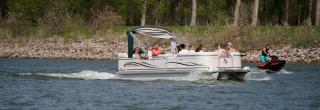
Behind the Badge - Boating Accident on Fourth of July Weekend
Boating Accident – Fourth of July Weekend
District Game Warden Noah Raitz
The Fourth of July weekend is one of the busiest stretch of days game wardens have during the summer.
Sure, there are busy days when the fish are biting, or the weather is perfect for a lake day.
But, without a doubt the Fourth of July will have recreators flocking to their lakes to get the boat on the water and enjoy the long weekend.
As lakes get crowded it becomes more important for boat operators to understand boating regulations and how to be safe on the water.
This starts at home before the boat is even hooked up.
One of the most common violations I find is not having the required number of personal flotation devices.
PFDs are usually stored in one of the front compartments or under the seats, depending on the type of boat.
It’s not uncommon for boat owners, who have enough PFDs, to struggle to remember which storage compartment they put them in.
Not knowing where your PFDs are stored on your boat is a safety concern because you never know when you might be put in an emergency where the PFD is needed.
While working the Fourth of July weekend in 2023, I received a call that a personal watercraft and a boat had collided.
I was at a nearby lake when it happened and was able to respond quickly.
I was told the boat had quickly started heading toward the boat ramp.
The caller told me it sounded like a shotgun blast when they collided.
The boat, almost full of passengers, was pulling a tuber and was making the typical “S” shaped maneuver as they followed the shoreline to a bend in the lake.
The PWC was heading toward this same bend from the opposite direction.
Once they recognized each other, they both attempted a turn but neither one was able to get out of the way.
A lot of questions started running through my head because an “accident” where nobody made a mistake is uncommon.
How close were they to the shoreline? Where was the attention of the driver? Who was the give-way vessel and who was the stand-on vessel? Was the throttle applied when the PWC attempted to turn? Almost all accidents are avoidable if state boating regulations are followed.
Upon arrival at the boat ramp, I could immediately see the boat that was involved in the collision was on a trailer with a large piece of the boat on the ground and a hole that matched it on the stern.
The driver said that when the collision happened, he could see water rushing in the back almost immediately.
He expressed that if he had not been able to drive the boat, they would have sunk within a few minutes.
The impact had enough force to bend the bow eye to one side along with multiple chunks of fiberglass missing on the PWC.
After the PWC collided with the boat, the momentum of both vessels caused the tuber to continue forward and collide with the PWC as well.
The tuber was able to lean to his side and keep the inner tube between himself and the PWC, acting as a cushion and bouncing him off.
The collision did not result in any injuries, but it was an extremely close call for everyone.
It’s hard to speculate what could have happened to the passengers if the collision happened a few seconds earlier or later, but I am almost certain there would have been more injuries.
Had the boat sunk, would all the passengers been able to swim to shore or locate a PFD?
What if the PWC operator hit his head and was knocked unconscious while the boat took off toward shore?
What if the tuber was unable to react fast enough and collided with the PWC before he could lean to his side?
Boat safety equipment and boating regulations are crucial for the safety of yourselves and others on the water.
The purpose of a PFD is to keep you upright in the water, even if you are unconscious.
Obviously, a PFD can’t stop a collision from happening, but it could save your life in an emergency.
It goes beyond just having a PFD though.
I would encourage everyone to review our boating regulations and if you have a question, call your local game warden.
